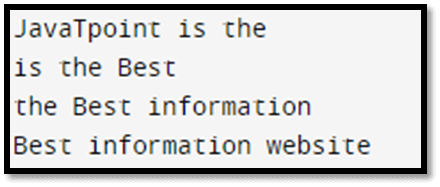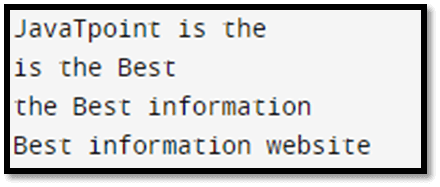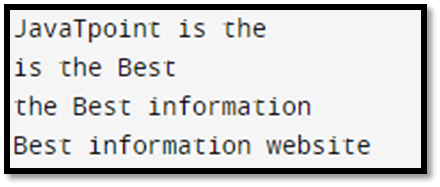Python Tutorial
Python OOPs
Python MySQL
Python MongoDB
Python SQLite
Python Questions
Plotly
Python Tkinter (GUI)
Python Web Blocker
Python MCQ
Related Tutorials
Python Programs
Python | Concatenate N consecutive elements in String listWorking with lists is a key part of programming in Python. We can store and modify collections of objects using the flexible data structures known as lists. We frequently get across situations where we need to combine successive components from a list to create a single string. In a variety of text processing, data manipulation, and string manipulation jobs, this procedure can be quite helpful. In this post, we'll look at how to use Python to concatenate N consecutive entries from a text list. Understanding the ProblemImagine you wish to create a single string by concatenating N consecutive components from a list of strings. For activities like extracting n-grams from text data or getting ready data for additional analysis, this can be important. For instance, suppose we had the list of strings below: If we want to concatenate 3 consecutive elements, the desired output would be: In this instance, we are creating new strings by concatenating three words at a time. Approach 1: Using List Slicing and JoiningUsing list slicing with the join() function provides an easy way to concatenate N consecutive entries in a string list. We use the join() function to combine strings. Code: Output: 
Using a sliding window of size N, the method concatenate_consecutive_elements() iterates across the list in this code. It extracts N consecutive elements using list slicing, then connects them using the space character as the delimiter. The concatenated_list, which is returned at the conclusion, contains the concatenated strings that were produced. Advantages of Using List Slicing and Joining:Explicit Control: The approach of using list slicing and the join() method provides explicit control over the iteration process. It is simple to comprehend how the iteration works and which pieces are being joined together. Easy Debugging: In case of errors or unexpected outputs, the traditional loop-based approach may be easier to debug due to its straightforward nature. Disadvantages of Using List Slicing and Joining:Less Concise: The code can become lengthier compared to the list comprehension approach, potentially resulting in more lines of code for the same task. Possibly Slower Execution: Depending on the size of the list and the value of N, using a loop might introduce a slight performance overhead when compared to more concise methods. Approach 2: Using List ComprehensionPython allows for elegant and concise solutions using list comprehensions. We can achieve the same concatenation task using a list comprehension: Code: Output: 
The list comprehension version achieves the same result as the previous approach, but with a more compact syntax. Advantages of Using List Comprehension:Concise Code: List comprehensions are known for their concise syntax. They let you to write less code to accomplish the same goal, which can enhance readability and maintainability. Efficiency: List comprehensions may perform better in some circumstances because the Python interpreter has optimized them. Functional Style: List comprehensions encourage a more functional programming style, which can be appealing to developers who prefer this approach. Disadvantages of Using List Comprehension:Debugging Complexity: Debugging complex list comprehensions can be more challenging due to their condensed syntax. Identifying the source of errors may require more effort. Approach 3: For Loop Approach:The for-loop approach involves iterating through the list and manually concatenating the desired number of consecutive elements. Code: Output: 
In this approach, the outer loop iterates through the list, and for each iteration, an inner loop concatenates N consecutive elements. The resulting concatenated string is then appended to the concatenated_list. Advantages of the For Loop Approach:Explicit Control: The nested for-loop structure provides clear control over how elements are concatenated, making the process easier to understand. Customizable Concatenation Logic: The for-loop approach gives you more flexibility in how you concatenate elements. You can incorporate additional logic or transformations as needed. Debugging: Debugging can be straightforward due to the linear and explicit nature of the loop. If errors occur, it's relatively easy to identify the specific iteration causing the issue. Disadvantages of the For Loop Approach:Code Length: The for-loop approach can result in longer and more verbose code compared to list comprehensions or using join(). Potentially Slower Execution: The manual concatenation process might be less efficient than built-in methods like join() in terms of performance, especially for larger lists. Readability: The nested loops might reduce code readability, particularly when dealing with complex concatenation tasks. ConclusionConcatenating N consecutive elements in a string list is a common task in text processing and data manipulation. With the help of list slicing, string joining, and list comprehensions, Python provides simple and efficient ways to tackle this challenge. Whether you opt for the traditional loop-based approach or the concise list comprehension method, understanding these techniques will empower you to manipulate string lists effectively in various programming tasks. |
 For Videos Join Our Youtube Channel: Join Now
For Videos Join Our Youtube Channel: Join Now
Feedback
- Send your Feedback to [email protected]
Help Others, Please Share










